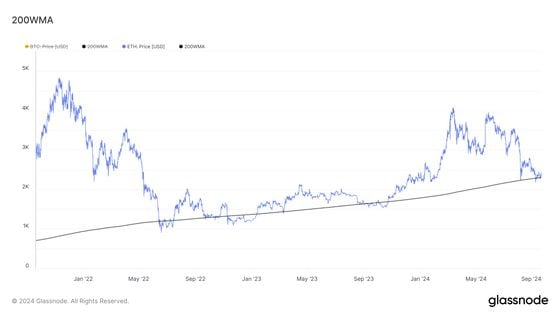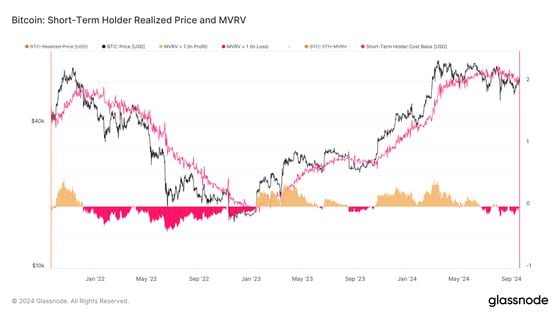
Ether (ETH) rose 2.5% in the past 24 hours, trading at around $2,434. More importantly, the second largest cryptocurrency has found key support at its 200-week simple moving average (SMA) of $2,298.
The 200-week SMA is a widely used tool for gauging long-term momentum. If the price of an asset rises above the marker, it is generally considered to be in an uptrend, and vice versa. The move higher was triggered after the U.S. Federal Reserve's decision to cut rates by 50 basis points, setting the current target rate between 4.75% and 5.00%.
Ether has bounced off this support multiple times, including on Aug. 5, when broader markets experienced a selloff triggered by the yen carry trade unwind. This support has held for much of September.

In the meantime, bitcoin (BTC) was changing hands at around $62,000 marking the first higher low for the token since its March all-time high, signaling constructive price action. To push further into bullish territory, bitcoin will need to break through the $65,000 resistance level, to mark a higher high and continue the upward momentum.
Bitcoin is also attempting to reclaim the short-term holder (STH) realized price of $61,998. The realized price represents the average on-chain acquisition cost for the entire supply, while the STH realized price reflects the average cost for coins moved within the last 155 days, which are the most likely to be spent.

Over the past six months, bitcoin has struggled to remain above this level. A sustained move above the STH realized price would suggest a more robust continuation of the bull market.
Looking ahead, macroeconomic factors could further influence both bitcoin and ether’s prices. On September 20, Japan is set to release inflation data, with expectations for both headline and core inflation to come in slightly hotter year-over-year, according to Trading Economics.
Additionally, the Bank of Japan (BoJ) will announce its interest rate decision, with markets expecting a pause at 0.25%. These events could add volatility to crypto markets, particularly as global monetary policy continues to influence investor sentiment across risk assets, including cryptocurrencies.
While a weak Japanese Yen would be bullish for bitcoin, a strong Japanese Yen would be bearish for bitcoin. While, the Hong Kong Monetary Authority (HKMA) also cut its base rate by 50 basis point (bps) to 5.25% on September 19, mirroring the Fed's interest rate cut. Hong Kong’s monetary policy tends to mirror the U.S. as the local currency is pegged to the U.S. dollar.
Bitcoin ETFs experienced their first outflow since September 11, with a total outflow of $52.7 million, according to data from Farside. The outflows were from Ark's ARKB ($43.4 million), Grayscale's GBTC ($8.1 million), and Bitwise's BITB ($3.9 million). Total inflows into bitcoin ETFs now stand at $17.4 billion.
As bitcoin and ethereum grapple with key technical levels, broader macroeconomic conditions, particularly in Japan and the U.S., may play a significant role in shaping price movements in the coming days.
免责声明:本文章仅代表作者个人观点,不代表本平台的立场和观点。本文章仅供信息分享,不构成对任何人的任何投资建议。用户与作者之间的任何争议,与本平台无关。如网页中刊载的文章或图片涉及侵权,请提供相关的权利证明和身份证明发送邮件到support@aicoin.com,本平台相关工作人员将会进行核查。




